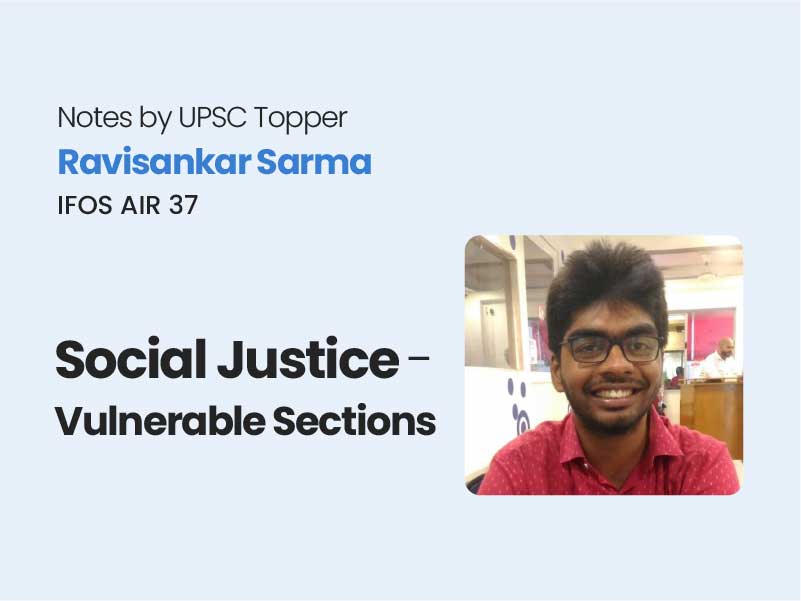Companion@360 → 7 Month programme to sharpen your writing skills → REGISTER NOW

A special cell for protecting inter-caste couples is formed in Madurai and Salem in the wake of honour killings
Commission to Enquire into Sub-Categorization of OBCs
- To examine the extent of inequitable distribution of benefits of reservation among various castes and communities that come under OBC bracket
- To work out a criteria, mechanism and parameters for sub-categorization whereby benefits accorded to communities deriving maximum benefits will now be redistributed to other communities who have not been able to gain as much
- Bringing order to central list of OBCs by removing any repetitions
- Union Cabinet has increased creamy layer for OBC reservation with regard to central government jobs
Analysis of Sub-Categorisation
- Equitable distribution of benefits of reservation where not only the well of sections within backward classes reap benefits but also the hitherto non-empowered sections are able to benefit
- Increasing the creamy layer can however enable financially well of communities to avail benefits of reservation which may hamper equity in distribution of benefits of reservation
- Can be an outcome or a cause of political mobilisation along caste lines with parties adopting vote bank politics to suit electoral requirements
- Communities that hitherto were successful in reaping benefits of the old system may feel alienated after sub-categorisation
Geriatric Health Care
GS 2 – Social Justice
Background
In 2010, Ministry of Health and Family Welfare initiated the National Programme for Healthcare for Elderly (NPHCE) aiming to provide affordable and accessible quality healthcare services to people over 60.
7 years from then, the Ministry’s survey shows that states have not fully used funds appropriated under this programme. (Remember health is a state subject while NPHCE is a GoI programme – Coverage disparity across states)
Bonded Labour
Bonded labour refers to forced labour against the wishes or discretions of the employee by intimidation and accumulated debt. An employee is often denied his or her wage and are subject to inhumane conditions of work.
Constitutional Safeguards
- The Indian Constitution abolishes bonded labour by Article 23
- The DPSP asks the state to endeavour in realising a living wage for its workers and ensure a humane condition for work
Statutory and Non-Statutory Interventions
Bonded Labour System (Abolition) Act, 1976: Empowers executive magistrates to exercise powers of judicial magistrate
- Vigilance Committee: To identify and rehabilitate bonded labours
- Scheme for Rehabilitation of Bonded Labourers: Centrally sponsored scheme where both centre and state governments contribute Rs 10k each for rehabilitation
Read Also Strategic disinvestment
Current Issues
According to the Global Slavery Index 2016, India has the highest number of slaves in the world at 18 million.
- Poor Enforcement of Bonded Labour: Under resourced police and judiciary
- Caste System: Societal inequalities rooted in caste and patriarchy have been exploited to perpetuate bondage labour and current power relationships in society
- Economic Inequity: Historically, bonded labour has occurred due to high level of indebtness among peasants denying them land rights forced to perform begar for landlords to repay their debt.
Solutions
- Better Enforcement: The human resource deficiency at police and judicial levels need to be met with for stricter implementation of existing bonded labour laws
- Reforming Laws: The conditions that can be manipulated to include elements of coercion and bondage in an employer-worker relationship shall be eliminated
- Inter-State Coordination Mechanisms: To provide protection to migrant workers, inter state coordination mechanisms shall be formed
- Social Security Schemes: Coverage of workers’ social security schemes shall be improved to reduce avenues for bondage and coercion and ensure greater protection for workers
RERA (Real Estate Regulation Authority Bill)
RERA was introduced to usher in transparency in real estate sector that has often been a medium for black money economy. RERA aims to safeguard consumers against arbitrary pricing and assurance for timely completion of projects.
Under RERA, each state can establish a Real Estate Regulatory and Appellate Authority.
All details of the project including timelines, cost and area will be shared for consumer in an online open portal that facilitates increased transparency.
